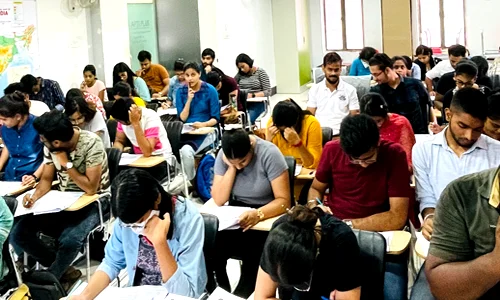



Global Capability Centres have become a cornerstone of India’s modern growth strategy, evolving from low-cost support units into global hubs for innovation, engineering, and strategic functions. Supported by skilled talent, strong digital infrastructure, and enabling government policies, GCCs contribute significantly to high-value exports, quality employment, and technological advancement. Their expansion is deepening India’s integration into global value chains and reinforcing its position as a leading knowledge and innovation-driven economy.
Click to View More
MGNREGA, renamed Pujya Bapu Gramin Rozgar Yojana, expands workdays to 125 and raises wages to boost rural livelihoods. While reforms promise stronger asset creation and women’s empowerment, delays in payments, employment gaps and administrative inefficiencies persist. Effective planning, transparency and accountability remain crucial for impact.
Click to View MoreA weaker rupee may boost export prices in the short run, but India’s long-term trade gains depend more on productivity, innovation, infrastructure and skilled labour. While depreciation can temporarily ease the trade gap, it also raises import costs, fuels inflation and risks capital flight in an import-dependent economy. Sustainable competitiveness therefore lies in strengthening real economic capabilities, supported by targeted policy measures such as incentives for exporters, attracting dollar inflows and stabilising forex markets.
Click to View MoreIndia’s Q2 FY26 GDP growth of 8.2% reflects strong momentum in manufacturing, services and corporate profitability, supported by policy-driven public investment. However, the weak nominal GDP growth, low GDP deflator, slowing agriculture, soft rural demand and subdued private investment reveal underlying structural pressures. These trends raise concerns about fiscal space, data reliability and the durability of the recovery, highlighting the need for broader demand strengthening, rural income support, and revival of private capital formation to ensure sustainable and inclusive growth.
Click to View MoreWomaniya, launched on GeM in 2019, supports women entrepreneurs and SHGs by allowing them to sell goods and services directly to government buyers. It promotes market access, fair pricing, and economic independence by integrating women-led enterprises into the formal public procurement system.
Click to View Morereduction in United States interest rates reshapes global capital movements and directly influences India’s financial landscape. Lower United States yields make emerging markets more attractive, potentially boosting foreign investment, easing borrowing conditions, and supporting growth through cheaper imports and improved liquidity. However, these benefits come with risks such as currency volatility, uncertain capital flows, export pressures, and inflationary spillovers. India must balance global monetary easing with domestic priorities—maintaining financial stability, strengthening structural reforms, and ensuring prudent macroeconomic management—to fully leverage opportunities while mitigating vulnerabilities.
Click to View MoreThe deletion of 2.7 million MGNREGS workers, linked to mandatory Aadhaar-based payments, has raised concerns of wrongful exclusion and erosion of the Act’s demand-driven rights. Critics argue technical errors removed genuine workers and call for optional technology, stronger audits and an inclusive, worker-centric approach.
Click to View MoreIndian federalism is competitive, with states vying for investment through reforms encouraged by NITI Aayog indices. This boosts innovation but risks regional inequality and unsustainable incentives. A balanced cooperative-competitive model is needed to pair healthy rivalry with equitable, sustainable national development.
Click to View MoreA G20 report by the World Inequality Lab warns that India’s wealth is heavily concentrated, with the top 1% holding 40.1% of national wealth while the bottom half owns only 6.4%. It urges G20 nations to impose a 2% global minimum tax on billionaires to curb inequality.
Click to View MoreIndia is developing a Climate Finance Taxonomy to guide sustainable investments and bridge a $170 billion annual climate finance gap by 2030. A CSEP report emphasizes that the taxonomy must be practical, inclusive, and aligned with domestic priorities while remaining credible to global investors. Key recommendations include supporting MSMEs, integrating adaptation finance, promoting indigenous innovations, and ensuring coordination between RBI, SEBI, and the Ministry of Finance. The framework should be dynamic, evolving with technology and market needs to effectively channel finance toward India’s real climate goals.
Click to View MoreThe US Federal Reserve recently cut its key interest rate by 0.25%, signaling two more cuts this year to support its slowing labor market. This move impacts India by influencing capital flows, currency value, borrowing costs, and inflation. While lower global rates can boost growth and investment, India faces risks like currency volatility, imported inflation, and banking sector stress. A balanced approach with monetary policy, fiscal prudence, and structural reforms is essential to leverage opportunities while safeguarding economic stability.
Click to View MoreIndia must reform outdated land-use planning to make cities true economic growth hubs. Achieving the $30 trillion goal and Net Zero target needs cities with job-linked visions, regional planning, Natural Resource Budgeting, and Climate Action Plans that ensure sustainable, resilient, and holistic urban growth.
Click to View More
© 2025 iasgyan. All right reserved